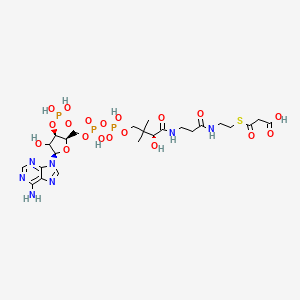| MeSH term | MeSH ID | Detail |
|---|---|---|
| Mercury Poisoning | D008630 | 4 associated lipids |
| Placental Insufficiency | D010927 | 6 associated lipids |
| Cytomegalovirus Infections | D003586 | 7 associated lipids |
| Cleft Lip | D002971 | 8 associated lipids |
| Protein-Energy Malnutrition | D011502 | 9 associated lipids |
| Myocardial Stunning | D017682 | 10 associated lipids |
| Ketosis | D007662 | 13 associated lipids |
| Mitochondrial Myopathies | D017240 | 13 associated lipids |
| Hypoglycemia | D007003 | 13 associated lipids |
| Cachexia | D002100 | 21 associated lipids |
Lmfa07050031
Lmfa07050031 is a lipid of Fatty Acyls (FA) class. The involved functions are known as Pigment and Polymerization. The related lipids are Propionate.
Cross Reference
Introduction
To understand associated biological information of Lmfa07050031, we collected biological information of abnormalities, associated pathways, cellular/molecular locations, biological functions, related genes/proteins, lipids and common seen animal/experimental models with organized paragraphs from literatures.
What diseases are associated with Lmfa07050031?
There are no associated biomedical information in the current reference collection.
Possible diseases from mapped MeSH terms on references
We collected disease MeSH terms mapped to the references associated with Lmfa07050031
PubChem Associated disorders and diseases
What pathways are associated with Lmfa07050031
There are no associated biomedical information in the current reference collection.
PubChem Biomolecular Interactions and Pathways
Link to PubChem Biomolecular Interactions and PathwaysWhat cellular locations are associated with Lmfa07050031?
There are no associated biomedical information in the current reference collection.
What functions are associated with Lmfa07050031?
Related references are published most in these journals:
| Function | Cross reference | Weighted score | Related literatures |
|---|
What lipids are associated with Lmfa07050031?
Related references are published most in these journals:
| Lipid concept | Cross reference | Weighted score | Related literatures |
|---|
What genes are associated with Lmfa07050031?
There are no associated biomedical information in the current reference collection.
What common seen animal models are associated with Lmfa07050031?
There are no associated biomedical information in the current reference collection.
NCBI Entrez Crosslinks
All references with Lmfa07050031
Download all related citations| Authors | Title | Published | Journal | PubMed Link |
|---|---|---|---|---|
| Thomson DM et al. | LKB1 and the regulation of malonyl-CoA and fatty acid oxidation in muscle. | 2007 | Am. J. Physiol. Endocrinol. Metab. | pmid:17925454 |
| Raney MA et al. | AMPK activation is not critical in the regulation of muscle FA uptake and oxidation during low-intensity muscle contraction. | 2005 | Am. J. Physiol. Endocrinol. Metab. | pmid:15547141 |
| Yee AJ and Turcotte LP | Insulin fails to alter plasma LCFA metabolism in muscle perfused at similar glucose uptake. | 2002 | Am. J. Physiol. Endocrinol. Metab. | pmid:12067845 |
| Gao S et al. | Important role of ventromedial hypothalamic carnitine palmitoyltransferase-1a in the control of food intake. | 2013 | Am. J. Physiol. Endocrinol. Metab. | pmid:23736540 |
| Takeyama N et al. | Altered hepatic fatty acid metabolism in endotoxicosis: effect of L-carnitine on survival. | 1989 | Am. J. Physiol. | pmid:2521428 |
| Goodwin GW and Taegtmeyer H | Regulation of fatty acid oxidation of the heart by MCD and ACC during contractile stimulation. | 1999 | Am. J. Physiol. | pmid:10516138 |
| Saha AK et al. | A malonyl-CoA fuel-sensing mechanism in muscle: effects of insulin, glucose, and denervation. | 1995 | Am. J. Physiol. | pmid:7653546 |
| Odland LM et al. | Human skeletal muscle malonyl-CoA at rest and during prolonged submaximal exercise. | 1996 | Am. J. Physiol. | pmid:8638703 |
| Winder WW et al. | Divergence of muscle and liver fructose 2,6-diphosphate in fasted exercising rats. | 1991 | Am. J. Physiol. | pmid:2035632 |
| Merrill GF et al. | AICA riboside increases AMP-activated protein kinase, fatty acid oxidation, and glucose uptake in rat muscle. | 1997 | Am. J. Physiol. | pmid:9435525 |
